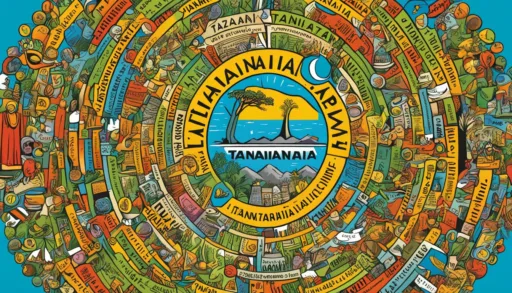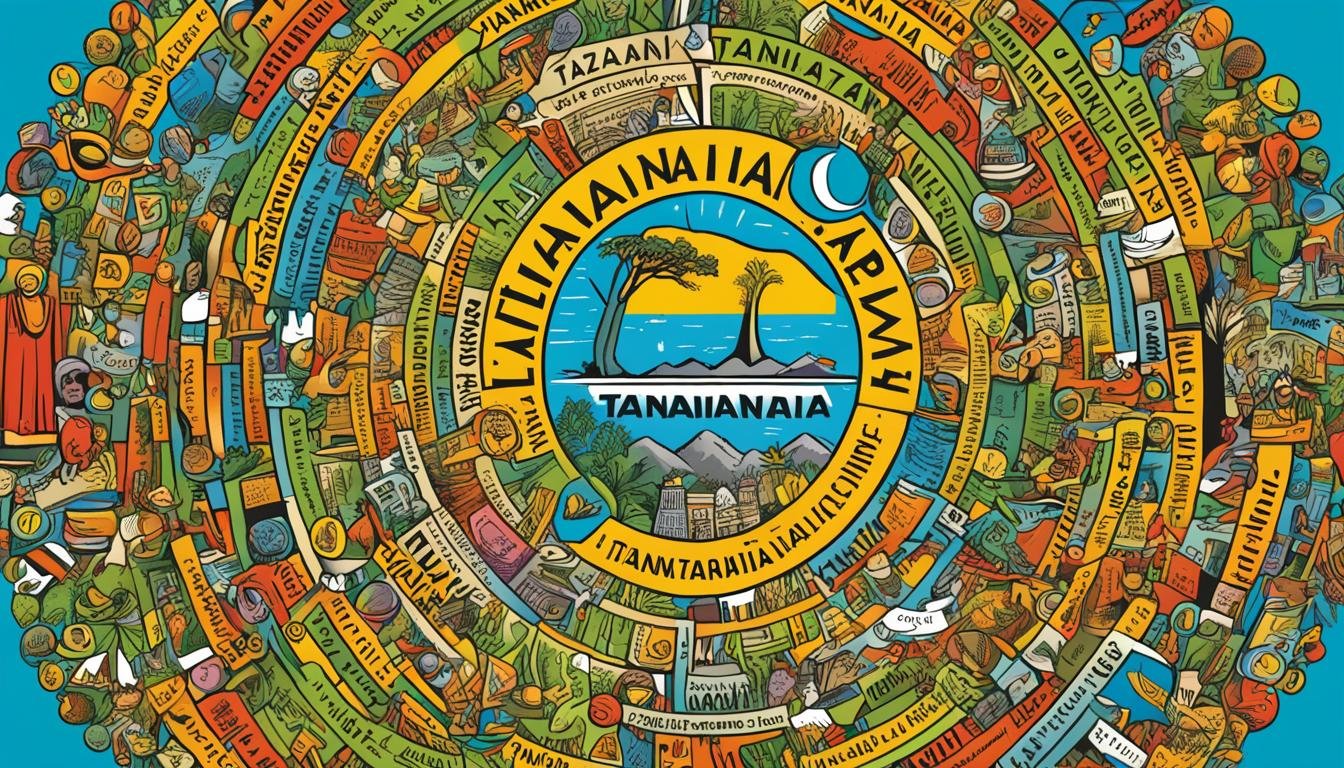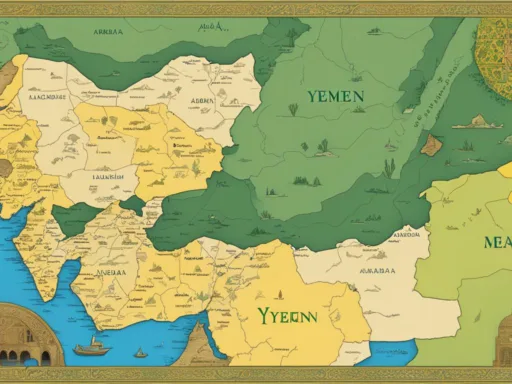Imagine a country so linguistically diverse that it boasts over 120 indigenous languages within its borders. Such is the case with Tanzania, a linguistic melting pot and a microcosm of the mother continent’s linguistic heritage. Swahili, famously known as the language of unity across East Africa, reigns as one of the official languages Tanzania prides itself on. However, the beauty of linguistic variety lies also in the numerous other languages spoken in Tanzania, each a thread in the country’s vibrant cultural fabric.
Not simply a tourist haven famed for Serengeti’s wildlife and Kilimanjaro’s peaks, Tanzania is also a linguistic enthusiast’s treasure trove. While the Tanzanian government has positioned the Swahili language in Tanzania as a vehicle of national identity, it also respects and acknowledges the kaleidoscope of languages that echo through the lives of its people daily. This commitment to multilingualism marks Tanzania as an exemplar among nations navigating the tides of globalization while maintaining their cultural sovereignty.
Key Takeaways
- Swahili stands proudly as Tanzania’s unifying national tongue amongst a total of 126 languages spoken.
- Preservation of linguistic diversity reflects the government’s recognition of Tanzania’s rich cultural heritage.
- From worldwide known Swahili to lesser-known indigenous languages, Tanzania’s commitment to multilingualism is evident.
- Understanding the official languages Tanzania supports—one indigenous and one international—offers insights into its historical journey and political foresight.
- The linguistic landscape of Tanzania is not only a key aspect of its identity but also attracts linguists and cultural enthusiasts from around the globe.
Linguistic Diversity in the Heart of Africa
Tanzania’s status as a cradle of linguistic diversity in Africa stems from its astounding variety of ethnic communities, numbering close to 129. This plurality of ethnicities in Tanzania has given birth to a vast spectrum of language families, making the country a fascinating focal point for studies in linguistic diversity.
The Ethnic Mosaic and Language in Tanzania
The intricate ethnic mosaic of Tanzania is reflected in its linguistic landscape, with the presence of Bantu, Cushitic, Nilotic, and Khoisan language groups. Each group brings its own rich cultural narratives to the country’s collective heritage, making Tanzania a country where communication and ethnicity intertwine in a complex tapestry of daily life. This reflects the incredible linguistic diversity in Tanzania, which is unparalleled on the continent.
Embracing Multilingualism: Tanzania’s Language Policies
Government efforts in Tanzania have long sought to embrace this linguistic and ethnic diversity while promoting social coherence and national identity. Presenting Swahili as the lingua franca is a key governmental strategy aimed at reduced ethnic divisions and enhanced communication in Tanzania. Swahili’s function spreads across political, social, and educational realms, whereas English—also an official language—is more specialized, utilized primarily within higher education and technical sectors. However, a shift towards instilling further language equity was signaled in a 2015 reform proposition: It suggested a downscaled role for English in educational settings, asserting the importance of indigenous languages in shaping national identity. This equilibrium between local and colonial languages underlines Tanzania’s unique linguistic policy approach that honors its ethnic diversity while fostering unity and communication.
The Role of Swahili as the National Language
The significance of the Swahili language in Tanzania transcends mere communication; it is the cornerstone of national pride and identity. This vibrant language weaves together the fabric of Tanzanian society, underscoring its importance not just locally but also as one of the official languages of Tanzania. With its roots intertwined in both Bantu and Arabic heritage, Swahili’s melodious rhythm is a daily soundtrack across Tanzania’s diverse communities.
Swahili’s Influence on Identity and Unity
Swahili, more than a means of expression, operates as a dynamic force uniting Tanzanians under a shared linguistic heritage. It plays a critical role in fostering a sense of community and solidarity, particularly in a country flourished with ethnic and linguistic diversity.
As the nation’s linguistic heartbeat, Swahili impacts every aspect of life, promoting unity and inclusivity across the East African plains. It champions a decolonized narrative, allowing citizens to claim their heritage in a language that belongs entirely to them.
Decolonization of Language: Swahili’s Ascendancy Over English
Post-independence Tanzania has seen a conscious shift towards elevating Swahili over English in an effort to decolonize the language landscape. This process not only reinforces national identity but also resonates with the masses who see Swahili as a symbol of autonomy and cultural pride.
The transition from Swahili at primary education levels to English in secondary schools is reflective of this complex interplay between languages. While it presents certain challenges, it also illustrates Tanzania’s resilience and commitment to preserving and nurturing its lingua franca.
In conclusion, the prominence and progression of Swahili in Tanzania not only define the country’s spirit but also chart its journey towards an independent and unified future, where language is a vessel for cultural celebration and national growth.
English in Tanzania: A Colonial Legacy
As a vestige of British colonial influence, the English language in Tanzania has endured as a significant component of the nation’s linguistic repertoire. While the prominence of Swahili language in Tanzania as the official language is pervasive, English continues to hold sway, primarily within urban settings and the educational domain. This linguistic duality is inherent to the modern Tanzanian identity, with English serving distinct purposes that reflect both historical contexts and contemporary demands.
The educational reforms initiated during President Jakaya Kikwete’s tenure led to a notable shift in language policy. English, once upheld as the primary medium of instruction from secondary education onward, saw its stature somewhat diminished; yet, its relevance in academia persists. English is still prevalent, ensuring Tanzania’s jeunesse remains competitive within international scholarly and professional circles, preserving a bridge to global advancements in science and technology.
Far from merely academic, the grasp of English offers tangible advantages in legal frameworks, furthering Tanzania’s capability to interface with international standards and protocols. Moreover, as Tanzania’s tourism industry flourishes, attracting adventurers to its renowned national parks and vibrant cityscapes, English emerges as an invaluable asset in hospitality and business, mediating countless transactions and enhancing cultural exchange.
Let us consider the following impacts of English in the context of Tanzania:
- Preservation of legal and administrative heritage from colonial times.
- Facilitation of international trade, investment, and diplomacy.
- Access to scientific literature and global knowledge bases.
- Enhanced tourism experiences in iconic destinations.
The continued utility of English intersects with the Tanzanian ethos; a country progressively harmonizing its rich traditions with the exigencies of an interconnected world.
Yet, it is essential to recognize that the essence of Tanzanian culture, its core and heartbeat, resonates profoundly through Swahili. However, the balanced coexistence with English enables Tanzanians to retain their cultural authenticity while navigating the complexities of a global landscape.
Languages Spoken Tanzania: A Comprehensive Overview
The tapestry of languages spoken in Tanzania is as diverse and multifaceted as the nation’s ethnic landscape. Within its borders, a conversation might flow in any one of the estimated 126 languages, each an echo of the country’s complex cultural past and its dynamic present. Central to this linguistic richness are the indigenous languages of Tanzania, including those from Bantu, Cushitic, Nilotic, and even the click-speaking Khoisan families. These indigenous tongues are not merely relics; they thrive in the mouths of millions, weaving through the daily lives of Tanzanians. Yet, amidst this variety, the Swahili language in Tanzania prevails as the unifying voice, bridging the multitude of dialects into one national discourse.
Each region, each community in Tanzania, resonates with its own linguistic identity – from the robust presence of Chaga in the northern slopes of Mount Kilimanjaro to the rhythm of Makonde in the south-eastern plateau. The following table details the prevalence and importance of several key languages spoken in Tanzania:
| Language Family | Language | Regional Use | Notable Features |
|---|---|---|---|
| Bantu | Swahili | National | Official language, used in all facets of national life |
| Bantu | Sukuma | Lake Zone | Largest ethnic group language in Tanzania |
| Bantu | Chaga | Kilimanjaro Region | Influential in local commerce and tourism |
| Bantu | Makonde | Mtwara Region | Idiomatic expressions rich in proverbs |
| Khoisan | Hadza | North-central Tanzania | Click consonants, small but vibrant community |
| Khoisan | Sandawe | Central Tanzania | Click sounds, known for hunting-gathering tradition |
This linguistic diversity exemplifies Tanzania’s commitment to the preservation of its cultural heritage, allowing each indigenous language to sustain its narrative in the broader story of the nation. Even as Swahili language in Tanzania unites, every local language enriches, providing depth and color to the country’s collective identity. Tanzania, thus, stands as a living library where oral traditions, folk stories, and the simple act of conversation are acts of cultural preservation.
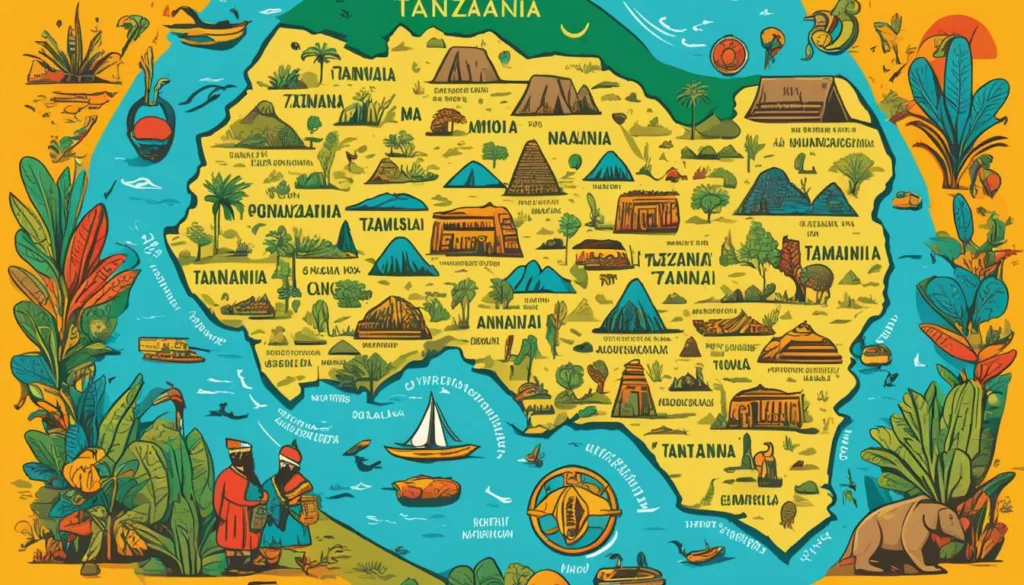
Regional and Minority Languages of Tanzania
Tanzania’s linguistic landscape is as diverse and vibrant as its ecosystems. While Swahili and English are the most prominent, an astonishing array of minority languages are the jewels in the nation’s cultural crown. These languages echo the societal values, history, and traditions of the ethnic groups they represent, maintaining a harmonious coexistence that is rarely seen on such a scale.
The Harmonious Coexistence of Tribal Languages
In Tanzania, the mosaic of tribal languages remains vibrant and vital. Among them, the sturdy Maasai language continues to resonate in the day-to-day lives of its speakers. Its reach extends beyond the borders into Kenya, shared through the rich cultural tapestry of the Maasai Mara. Meanwhile, the Digo language articulates the heritage of its people along the coastal regions, and the Datooga language endures through the plains of the Tanzanian highlands with persistence and pride.
Virtually resisting the tides of linguistic assimilation, Chindali remains robust, its speakers fostering its distinctiveness and upholding their ancestral linguistic identity. This resilience against the homogenization of language reflects a broader Tanzanian respect for cultural diversity. Even the rhythm of Arabic, especially poignant in Zanzibar, persists, its use in religious and cultural contexts a testament to the archipelago’s storied past and present.
These minority languages of Tanzania are not mere relics of a bygone era but are active participants in the country’s evolving narrative—each voice an invaluable thread in the tapestry that is Tanzania’s identity. In protecting these languages, Tanzanians protect their history and their very essence, ensuring that future generations can continue to hear the multitude of stories that their homeland has to tell.
Swahili Language Tanzania: From Trade to National Tongue
In the vibrant nation of Tanzania, the Swahili language manifests not only as a means of daily communication but also as a beacon of cultural identity. Historically, Swahili emerged from the bustling inter-cultural trade between Bantu settlers and Arab merchants, ingraining it deeply into the fabric of East African society.
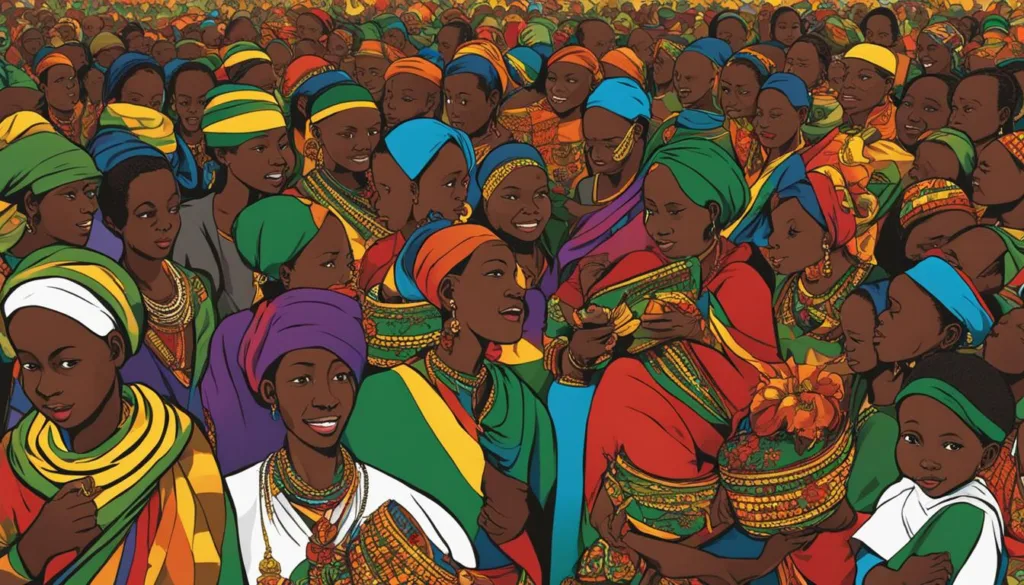
This language of trade evolved with the country through centuries, ascending the ranks to become one of the official languages of Tanzania. Swahili stands out as a linguistic testament to unity, melding diverse communities into a single, harmonious nation. Its significance is further highlighted by its transition from Arabic script into the widely accessible Latin alphabet, boasting increased literacy and communication within the country and among its neighbors.
Furthermore, the adoption of Swahili as the national tongue of Tanzania is symbolic, representing the country’s stride towards independence and self-determination. This shift is not merely linguistic; it epitomizes the essence of nationhood and the collective identity of Tanzanians.
Swahili language, a vessel of trade, governance, and communication, stands tall as Tanzania’s cherished voice, articulating the nation’s tales of togetherness and sovereign pride.
- Originated from trade interactions
- Became the lingua franca of East Africa
- Adopted as the national language to unify Tanzania’s diverse ethnic groups
- Transitioned from Arabic to Latin script, broadening its accessibility
- Symbolizes independence and Tanzanian identity
Today’s Swahili is more than a language; it’s a reflection of Tanzania’s history, a bridge connecting its present with the future, and a shared voice for its people to step onto the global stage confidently.
Indigenous Languages Tanzania: Preserving Cultural Heritage
Tanzania’s cultural heritage is profoundly tied to its linguistic diversity. The country is widely recognized for its rich tapestry of indigenous languages, which are crucial in maintaining the connections to its multifaceted past. The government of Tanzania has demonstrated a laudable commitment to the support and conservation of indigenous languages, recognizing them as pillars of the nation’s identity.
Amongst the variety of indigenous languages, notable are those like Hadza and Sandawe. For the Hadza, their language is an integral part of their hunter-gatherer lifestyle and a distinct reflection of their culture. Similarly, the Sandawe language preserves the unique click consonants, a feature reminiscent of the earliest forms of human speech.
The preservation of these languages goes beyond cultural significance; it plays an essential role in the academic study of language and its development. Researchers and scholars alike draw important insights from the features and origins of Tanzania’s indigenous languages.
| Language Name | Language Family | Estimated Number of Speakers | Notable Features |
|---|---|---|---|
| Hadza | Language Isolate | 1,000-2,000 | Click consonants |
| Sandawe | Khoisan | 40,000 | Click consonants, tone system |
| Maasai | Nilo-Saharan | 1.3 million | Vowel harmony, three-way vowel length distinction |
| Sukuma | Niger-Congo | 7.6 million | Bantu language, extensive verb conjugations |
| Chaga | Niger-Congo | 2 million | Bantu language, elaborate noun class system |
Respecting and promoting the country’s linguistic diversity is not just a nod to the past; it’s an investment in a multicultural legacy that enriches Tanzania. By acknowledging these languages and working towards their survival, Tanzania helps maintain the incredible breadth of human language and thought. As these indigenous languages are celebrated, Tanzania’s linguistic diversity Tanzania shines as a critical part of its present-day identity and as a foundation for its future cultural narrative.
Tanzania’s Education System and Language Mediums
Within the broad spectrum of Tanzania’s education system, the choice of language mediums plays a pivotal role in shaping the academic and cultural landscape. From the earliest levels of schooling, language serves not just as a tool for communication but also as a marker of identity and a path toward societal unity.
Swahili’s Dominance in Primary Education
The Swahili language in Tanzania is more than a means of communication; it is a binding thread that weaves together the nation’s rich cultural fabric. In primary education, the language’s ubiquity is evident, fostering a sense of national pride and common identity among young learners, all while providing a strong foundation for their academic journey.
English in Secondary and Higher Education: A Transactional Change
As students ascend into secondary and higher education tiers, they encounter a shift, moving from the Swahili language to English. This transition not only marks a new phase in their educational careers but also aligns with global economic and social integration, which calls for a different skill set and multilingual fluency.
In light of the significant role that language plays in Tanzania’s education system, a comparative overview of primary versus secondary education showcases these dynamic linguistic choices:
| Education Level | Medium of Instruction | Focus |
|---|---|---|
| Primary Education | Swahili | Cultural integration, national identity |
| Secondary Education | English | Preparation for global market, advanced specialization |
| Higher Education | English | Professional and technical proficiency, international competitiveness |
The strategic use of both Swahili and English in Tanzania’s education system reflects a nuanced approach to preserving indigenous language while embracing global communicative needs. This forward-looking vision prepares Tanzanian students for local and international success.
Official Languages Tanzania: A Dual-Language Nation
In the heart of East Africa, Tanzania shines as a beacon of linguistic duality. The harmonious balance between Swahili and English underlies the nation’s rich cultural tapestry and its functioning as an inclusive dual-language state. While Swahili provides the cohesive fabric for everyday life, English complements this by facilitating specialized domains and international relations.
The Duality of Swahili and English in Official Matters
Swahili is the bedrock of communication in Tanzania, weaving through government, political discourse, and primary education with the ease of a native tongue. It stands as a living symbol of national solidarity, embraced by all layers of society. English, with its roots in the country’s colonial past, reveals a different facet of the Tanzanian identity—its global outreach and modern aspirations. This linguistic pairing is not just about day-to-day functionality; it’s a reflection of Tanzania’s complex history and its present-day strategies for engaging on an international stage.
| Language | Role in Tanzania | Domain of Usage |
|---|---|---|
| Swahili | National language and symbol of unity | Government, public discourse, primary education, social communication |
| English | Official language for secondary domains | Secondary and higher education, judicial system, technical fields |
The official languages of Tanzania serve to not only aid in administration and education but also to uphold the cultural integrity of a nation that prides itself on unity in diversity. By maintaining Swahili and English in their respective spheres, Tanzania exemplifies a successful model of linguistic diversity that supports both national identity and global communication.
Linguistic Challenges and Opportunities in Tanzania
The cultural landscape of Tanzania is a vibrant mosaic of tongues, with the linguistic diversity encompassing over 120 languages spoken throughout the nation. This remarkable variety provides a wealth of opportunities for cultural enrichment and academic study. Yet, it also gives rise to unique challenges that affect communication in Tanzania and beyond its borders.
Communication within such a linguistically varied context can be as enriching as it is complex. Learning and integrating multiple languages from childhood can lead to cognitive advantages and a deeper understanding of cultural nuances. However, for a nation that prides itself on linguistic unity through Swahili, the existence of many indigenous languages complicates the landscape, especially regarding education and administration.
The educational system particularly reflects these linguistic challenges. A significant policy shift saw Tanzania transition from Swahili to English medium in secondary education. This change poses a considerable barrier to those students who are more adept in their native languages or Swahili. The lack of proficiency in English among some students may hinder their academic progression and possibly affect their future career opportunities.
Conversely, Tanzania’s linguistic tapestry is not merely an obstacle but a vast reservoir of cultural wealth. It offers unparalleled opportunities for preserving cultural heritage and for researchers delving into the realms of linguistics and anthropology. It also poses the exciting potential for educational reform that could develop bilingual or even multilingual proficiency, equipping students with versatile skills for a globalizing world.
Tanzania stands as a beacon of linguistic diversity, thriving on its rich heritage while navigating the intricate pathways of modern communication and education.
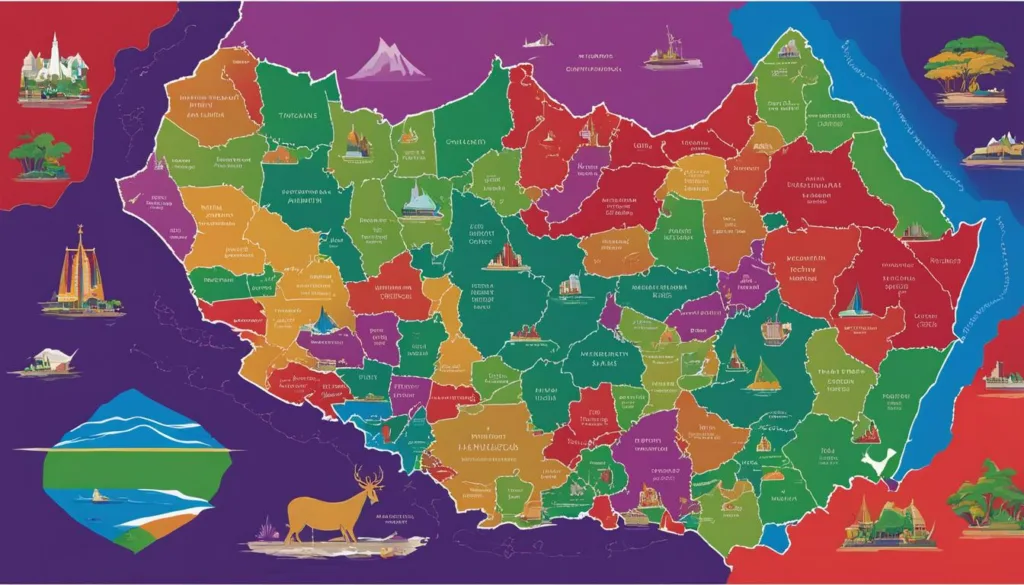
To better understand the impact of linguistic diversity on education and communication, consider the following table that compares different family languages and the number of speakers in Tanzania:
| Language Family | Number of Languages | Estimated Speakers |
|---|---|---|
| Bantu | 95 | Over 30 million |
| Nilotic | 16 | Approximately 2.5 million |
| Cushitic | 4 | Approximately 500,000 |
| Khoisan (including Sandawe and Hadza) | 2 | Less than 50,000 |
In essence, while the linguistic diversity of Tanzania presents certain challenges, it also holds the key to unlocking a myriad of opportunities that can further enrich the nation’s cultural tapestry and educational standing.
Conclusion
The mosaic of languages spoken in Tanzania mirrors the nation’s tapestry of traditions and ethnic backgrounds, offering a window into its storied past and evolving present. From the ubiquity of Swahili, enshrined as the national tongue, to the diverse expressions of ethnic and regional idioms, Tanzania showcases linguistic diversity that is as wide as it is deep. In policies that champion linguistic richness, the nation not only underscores its commitment to cultural identity but also forges a path toward collective harmony.
Embracing Tanzania’s Language Richness in a Globalized World
Amidst the waves of globalization, Tanzania balances preservation with progress, honoring its linguistic heritage while engaging in international dialogue. The linguistic diversity Tanzania boasts is not merely a historical relic but a living, breathing aspect of its social fabric that enhances its global appeal. This linguistic wealth, far from being esoteric, provides opportunities for cross-cultural connection and understanding, positioning Tanzania as a compelling confluence of heritage and modernity for both linguists and travelers alike.
As the world draws closer in communication and interaction, Tanzania’s approach to nurturing its linguistic landscape is instructive. It demonstrates how languages can serve as bridges rather than barriers, promoting unity and retaining identity in an increasingly interconnected world. The full spectrum of languages spoken in Tanzania thus becomes not just a point of national pride but a significant contributor to the country’s allure on the global stage.
FAQ
What Languages are Spoken in Tanzania?
Tanzania is home to approximately 126 languages including the official national language Swahili, and English which is used as a lingua franca. Other languages spoken include indigenous languages from the Bantu, Nilo-Saharan, Cushitic, and Khoisan language families, as well as minority languages like Arabic, particularly in Zanzibar, and Indian languages among immigrant communities.
What is the Official Language of Tanzania?
Swahili is the official language of Tanzania. It is used extensively in government, education, and media. English is also considered an official language, particularly for secondary and higher education as well as judicial matters.
How Does the Ethnic Diversity of Tanzania Relate to Language?
Tanzania’s vast ethnic diversity, with approximately 129 ethnic groups, reflects in its rich linguistic landscape. There is a variety of languages from four major language groups – Bantu, Cushitic, Nilotic, and Khoisan. The ethnic mosaic of the country influences communication patterns and the prevalence of certain languages in different regions.
How are Language Policies Structured in Tanzania?
In Tanzania, language policies are designed to promote Swahili as the unifying national language. Swahili is emphasized in social, political, and educational settings, while English is used in higher education and specialized sectors. There has been a policy shift with efforts to reduce the use of English in schools, to strengthen the role of Swahili and other indigenous languages.
What Role Does Swahili Play in Tanzanian National Identity?
Swahili plays a central role in fostering Tanzanian national consciousness and unity. It serves as the most prevalent language and is integral in various facets of life, including politics, education, and daily communication. The use of Swahili promotes a sense of shared national identity among the diverse ethnic groups in Tanzania.
How Has Swahili Language Policy Changed Over the Years?
Swahili has become increasingly dominant in the Tanzanian education system, particularly at the primary level with efforts to decolonize the language landscape. Governmental reforms have also been introduced to encourage the use of Swahili over English in schools, as seen in the 2015 educational policy.
What is the Status of English Language in Tanzania Today?
English retains a significant position in Tanzania, mainly in urban areas, higher education, the legal system, and the business sector. Despite educational reforms to emphasize Swahili, English continues to be important in the global economy and is used for international communication.
What are Some Noteworthy Indigenous and Regional Languages of Tanzania?
Tanzania showcases a diverse array of indigenous languages that include larger communities speaking Chaga, Makonde, and Sukuma, as well as smaller groups such as the Hadza and Sandawe who are known for their click sounds. Maasai, Digo, and Arab-influenced languages in areas such as Zanzibar are also significant.
How Have Tanzania’s Educational Language Policies Evolved?
Tanzania’s educational language policies have evolved to promote Swahili as the medium of instruction in primary schools, with the transition to English in secondary and tertiary levels. Past reforms proposed to minimize the use of English in the education system to enhance the role of Swahili and indigenous languages.
How do Swahili and English Coexist in Official Capacities in Tanzania?
Swahili and English coexist as Tanzania’s official languages. Swahili is predominantly used in government, social settings, and primary education, while English remains the medium for higher education, technical sectors, and legal proceedings. This duality allows effective communication within and outside the nation.
What Challenges Does Linguistic Diversity Present in Tanzania?
Linguistic diversity in Tanzania presents challenges in education where the switch from Swahili to English can impact students’ academic performance. It also poses communication challenges across different ethnic groups. Nevertheless, it provides opportunities for cultural expression and heritage preservation, alongside academic research.
How is Linguistic Diversity in Tanzania an Opportunity for the Nation?
The vast linguistic diversity is an asset for Tanzania, highlighting its rich cultural heritage and offering a unique attraction for tourism. It strengthens the national identity and preserves the myriad of languages spoken across the country. It also provides a fertile ground for linguists and researchers interested in studying language development and cultural history.
